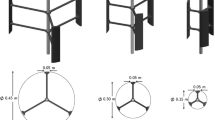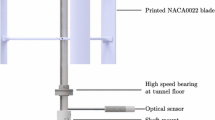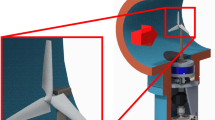Abstract
We present experimental data to compare and contrast the wake characteristics of a turbine whose rotation is either driven by the oncoming flow or prescribed by a motor. Velocity measurements are collected using two-dimensional particle image velocimetry in the near-wake region of a lift-based, vertical-axis turbine. The wake of this turbine is characterized by a spanwise asymmetric velocity profile which is found to be strongly dependent on the turbine tip speed ratio (TSR), while only weakly dependent on Reynolds number (Re). For a given Re, the TSR is controlled either passively by a mechanical brake or actively by a DC motor. We find that there exists a finite region in TSR versus Re space where the wakes of the motor-driven turbine and flow-driven turbine are indistinguishable to within experimental precision. Outside of this region, the sign of the net circulation in the wake changes as TSR is increased by the motor. Shaft torque measurements show a corresponding sign change above this TSR threshold set by circulation, indicating a transition from net torque due to lift to net torque due to drag produced by the turbine blades, the latter of which can give wake measurements that are inconsistent with a flow-driven turbine. The results support the claim that the turbine kinematics and aerodynamic properties are the sole factors that govern the dynamics of its wake, irrespective of the means to move the turbine blades. This has significance for both experimental and computational studies where it may be necessary, or perhaps more economical, to prescribe the turbine kinematics in order to analyze its aerodynamic characteristics.


























Similar content being viewed by others
References
Bachant P, Wosnik M (2014) Reynolds number dependence of cross-flow turbine performance and near-wake characteristics. In: Proceedings of the 2nd Marine energy technology symposium, Seattle
Bahaj A, Batten W, McCann G (2007) Experimental verifications of numerical predictions for the hydrodynamic performance of horizontal axis marine current turbines. Renew Energ 32:2479–2490
Battisti L, Zanne L, Anna SD (2011) Aerodynamic measurements on a vertical axis wind turbine in a large scale wind tunnel. J Energ Resour 133:031201
Bazilevs Y, Hsu MC, Kiendl J, Wüchner R, Bletzinger KU (2011) 3D simulation of wind turbine rotors at full scale. Part II: fluid-structure interaction modeling with composite blades. Int J Numer Methods Fluids 65:236–253
Cal RB, Lebrón J, Castillo L, Kang HS, Meneveau C (2010) Experimental study of the horizontally averaged flow structure in a model wind-turbine array boundary layer. J Renew Sustain Energy 2:013106
Chamorro LP, Arndt REA, Sotiropoulos F (2011) Turbulent flow properties around a staggered wind farm. Bound-Lay Meteorol 141:349–367
Chan AS, Dewey PA, Jameson A, Liang C, Smits AJ (2011) Vortex suppression and drag reduction in the wake of counter-rotating cylinders. J Fluid Mech 679:343–382
Chao DD, van Dam CP (2007) Computational aerodynamic analysis of a blunt trailing-edge airfoil modification to the NREL Phase VI rotor. Wind Energy 10:529–550
Duque EP, Burklund MD, Johnson W (2003) Navier-Stokes and comprehensive analysis performance predictions of the NREL phase VI experiment. J Sol Energ 125:457–467
Ebert PR, Wood D (1997) The near wake of a model horizontal-axis wind turbine—I. Experimental arrangements and initial results. Renew Energ 12:225–243
Ferreira CS, van Kuik G, van Bussel G, Scarano F (2009) Visualization by PIV of dynamic stall on a vertical axis wind turbine. Exp Fluids 46:97–108
Fujisawa N, Shibuya S (2001) Observations of dynamic stall on Darrieus wind turbine blades. J Wind Eng Ind Aerod 89:201–214
Grant I, Parkin P (2000) A DPIV study of the trailing vortex elements from the blades of a horizontal axis wind turbine in yaw. Exp Fluids 28:368–376
Howell R, Qin N, Edwards J, Durrani N (2010) Wind tunnel and numerical study of a small vertical axis wind turbine. Renew Energ 35:412–422
Hsu MC, Bazilevs Y (2012) Fluid-structure interaction modeling of wind turbines: simulating the full machine. Comput Mech 50:821–833
Kang HS, Meneveau C (2010) Direct mechanical torque sensor for model wind turbines. Meas Sci Technol 21:105206
Korobenko A, Hsu MC, Akkerman I, Bazilevs Y (2014) Aerodynamic simulation of vertical-axis wind turbines. J Appl Mech 81:021011
Le TQ, Lee KS, Park JS, Ko JH (2014) Flow-driven rotor simulation of vertical axis tidal turbines: a comparison of helical and straight blades. Int J Nav Archit Ocean Eng 6:257–268
Li ZC, Sheng QH, Zhang L, Cong ZM, Jiang J (2012) Numerical simulation of blade-wake interaction of vertical axis tidal turbine. Adv Mat Res 346:318–323
Lida A, Kato K, Mizuno A (2007) Numerical simulation of unsteady flow and aerodynamic performance of vertical axis wind turbines with LES. In: Proceedings of the 16th Australasian fluid mechanics conference. Crown Plaza, Gold Coast
Martinelli L, Smits AJ (2012) High-fidelity computational fluid dynamics (CFD) for the wind/tidal energy industry. In: Proceedings of the HKIE civil division international conference, Hong Kong
Nini M, Motta V, Bindolino G, Guardone A (2014) Three-dimensional simulation of a complete vertical axis wind turbine using overlapping grids. J Comput Appl Math 270:78–87
Shamsoddin S, Porté-Agel F (2014) Large eddy simulation of vertical axis wind turbine wakes. Energies 7:890–912
Tescione G, Ragni D, He C, Ferreira CJS, van Bussel G (2014) Near wake flow analysis of a vertical axis wind turbine by stereoscopic particle image velocimetry. Renew Energ 70:47–61
Theunissen R, Sante AD, Riethmuller ML, den Braembussche RAV (2008) Confidence estimation using dependent circular block bootstrapping: application to the statistical analysis of PIV measurements. Exp Fluids 44:591–596
Welch PD (1967) The use of fast Fourier transform for the estimation of power spectra: a method based on time averaging over short, modified periodograms. IEEE Trans Audio Electroacoust 15:70–73
Whittlesey RW, Dabiri JO (2013) Optimal vortex formation in a self-propelled vehicle. J Fluid Mech 737:78–104
Xu G, Sankar LN (2000) Computational study of horizontal axis wind turbines. J Sol Energ 122:35–39
Acknowledgments
This work was funded by an NSF Graduate Research Fellowship as well as the Caltech Resnick Institute Graduate Fellowship to D.B.A. Funding to J.O.D. from the Gordon and Betty Moore Foundation through Grant No. GBMF2645 and the Office of Naval Research through Grant N000141211047 are also gratefully acknowledged.
Author information
Authors and Affiliations
Corresponding author
Appendix
Rights and permissions
About this article
Cite this article
Araya, D.B., Dabiri, J.O. A comparison of wake measurements in motor-driven and flow-driven turbine experiments. Exp Fluids 56, 150 (2015). https://doi.org/10.1007/s00348-015-2022-7
Received:
Revised:
Accepted:
Published:
DOI: https://doi.org/10.1007/s00348-015-2022-7




